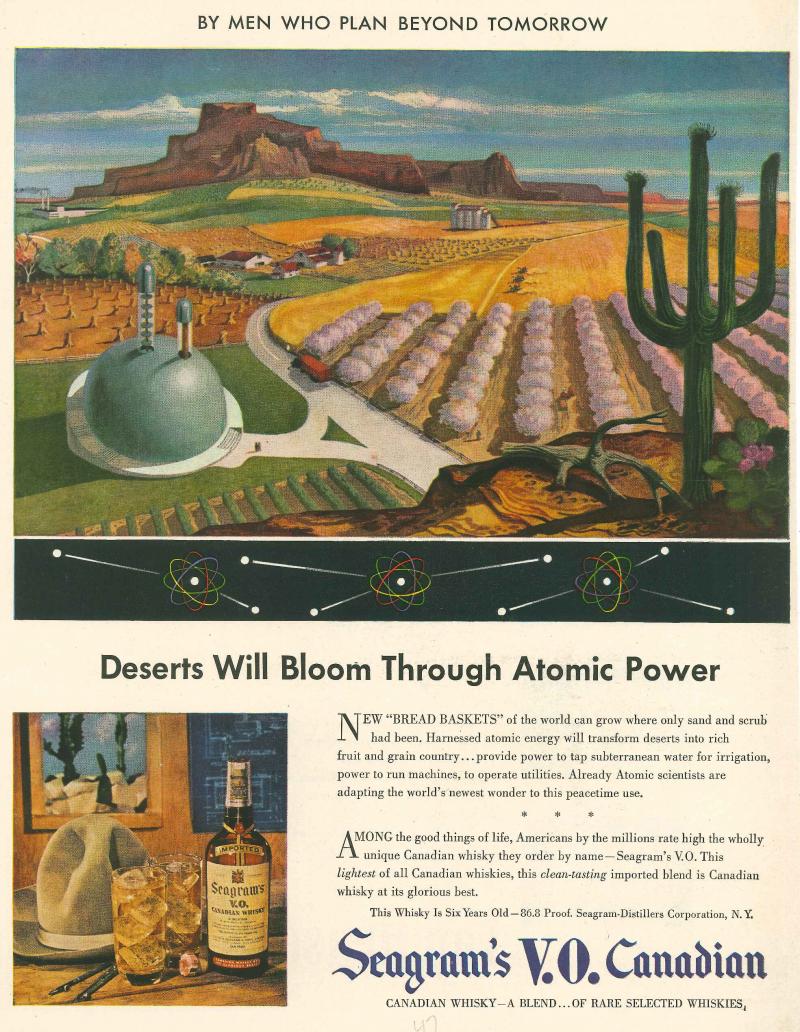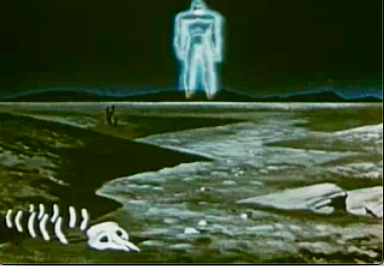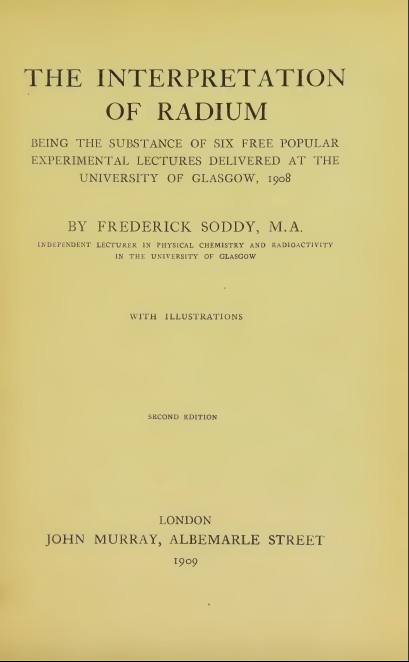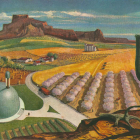In the 1940s, the Seagram Company introduced a series of print advertisements with the theme “By the Men Who Plan Beyond Tomorrow.” Ads ran in popular magazines such as Life, Collier’s, and The New Yorker. Each one featured a color illustration of a technological innovation that seemed to be futuristic, yet also plausible and somehow close at hand. The advertising copy explained the novel technology in the picture and credited the unseen men planning “beyond tomorrow.” Of course, Seagram’s was a purveyor of Canadian blended whiskey, not a wartime or postwar defense contractor. Some ads made the connection between technoscience and liquor quite plain: “Men Who Plan Beyond Tomorrow Like CANADIAN Whisky at Its Glorious Best.” The explanation continued by highlighting famous events that had taken place in the years while the whiskey was aging in barrels. Thus, Seagram’s too was planning for the future, supporting the creation and enjoyment of forthcoming wonders.

“Deserts Will Bloom” appeared in American magazines as part of a futuristic marketing campaign by the Seagram Company. This advertisement debuted in 1947, the same year that the Atomic Energy Commission began operation as the supervisory body for American nuclear development.
“Deserts Will Bloom” appeared in American magazines as part of a futuristic marketing campaign by the Seagram Company. This advertisement debuted in 1947, the same year that the Atomic Energy Commission began operation as the supervisory body for American nuclear development.
LIFE Magazine, 12 May 1947.
 This work is licensed under a Creative Commons Public Domain Mark 1.0 License.
This work is licensed under a Creative Commons Public Domain Mark 1.0 License.
The Seagram Company’s ads comprise a fascinating body of work, exhibiting midcentury graphic design and technological optimism. One in particular stands out for its intriguing blend of the pastoral and the industrial. Entitled “Deserts Will Bloom Through Atomic Power,” this 1947 ad pictures a terraformed desert valley with a farm that runs on atomic power. The ad copy explains, “New ‘BREAD BASKETS’ of the world can grow where only sand and scrub had been. Harnessed atomic energy will transform deserts into rich fruit and grain country.” We do not see the men planning this nuclear-powered tomorrow, but in the smaller image below, we can glimpse their accoutrements: a blueprint, drawing compass, campaign hat, bottle of Seagram’s, and two full highball glasses. The phantom masculine figures are portrayed as rugged men taming rugged land, yet still sophisticated in their intellect and taste.
Several years later, a transformation similar to that of the Seagram’s ad appeared in A is for Atom, a 1952 animated film created by John Sutherland Productions for General Electric. During the closing montage, a glowing giant figure looms over a desert landscape hostile to cultivation—with a sun-bleached cattle skeleton driving home the point. Through the power of the atom, this embodiment of atomic energy (and the nuclear industry) transforms the desert into a bucolic landscape not unlike the one in the Seagram’s ad. While “Deserts Will Bloom” and A is for Atom may seem like little more than Cold War curiosities, these cultural ephemera can point us in a fruitful interpretive direction.

General Electric Company and John Sutherland Productions, 1952.
Courtesy of Internet Archive and Prelinger Archives.
 This work is licensed under a Creative Commons Public Domain Mark 1.0 License.
This work is licensed under a Creative Commons Public Domain Mark 1.0 License.

General Electric Company and John Sutherland Productions, 1952.
Courtesy of Internet Archive and Prelinger Archives.
 This work is licensed under a Creative Commons Public Domain Mark 1.0 License.
This work is licensed under a Creative Commons Public Domain Mark 1.0 License.
A is for Atom was a 1952 pro-nuclear animated film that John Sutherland Productions created for the General Electric Company. These images are taken from a closing montage that showcases “peaceful” uses of atomic energy. In the first frame, the glowing atomic giant looms over a desolate landscape. In the second frame, the giant has instantaneously transformed the desert into a verdant cultivated valley. The entire desert-to-farm sequence elapses in six seconds.
The idea of atomic transformation from supposed wasteland to cultivated land was a recurring one in atomic discourse. In his 1909 collected lectures, The Interpretation of Radium, British chemist Frederick Soddy predicted that atomic energy in the hands of humans “could transform a desert continent … and make the whole world one smiling Garden of Eden.” Half a century later, science journalist William “Atomic Bill” Laurence wrote an ode to the “Great Promise of the Atomic Age” for The New York Times Magazine. Even amid widespread fears about nuclear contamination, Laurence envisioned a world where the “vast power of the atom can open to the use of man the wealth in the world’s wastelands.” His optimism resonated with the concerted effort by the American government to promote the “peaceful use of atomic energy” as the benevolent long-term payoff of nuclear danger.

The Interpretation of Radium collects six lectures that British chemist Frederick Soddy delivered in 1908. In the lectures, Soddy provided a primer on atomic theory and offered his hopes for future atomic applications. He received the 1921 Nobel Prize for Chemistry for his work on radioisotopes and other aspects of radioactivity.
The Interpretation of Radium collects six lectures that British chemist Frederick Soddy delivered in 1908. In the lectures, Soddy provided a primer on atomic theory and offered his hopes for future atomic applications. He received the 1921 Nobel Prize for Chemistry for his work on radioisotopes and other aspects of radioactivity.
Frederick Soddy, The Interpretation of Radium, 1908.
Courtesy of the Internet Archive. Click here to view image source.
 This work is licensed under a Creative Commons Public Domain Mark 1.0 License.
This work is licensed under a Creative Commons Public Domain Mark 1.0 License.
While these wasteland-to-farmland hopes appear in different circumstances with varying intents, I argue that they are instances of the Edenic recovery narrative that historian Carolyn Merchant identified in Western environmental discourse. As Merchant observes, the promise of a renewed Edenic paradise has historically masked programs of conquest, exploitation, and destruction. Visions such as those from Seagram’s and General Electric offer idyllic, bucolic landscapes, but as with other pastoral art and writing, much is obscured. They mask possible or actual legacies of land seizure and other dispossessions, contamination, and pollution. Of course, there is also the fundamental assumption that these lands are no more than “waste” and only valuable when cultivated in designated ways.
Were promises of agricultural advantage completely disingenuous? As a wave of recent scholarship has shown, atomic researchers did pursue applications for agriculture, primarily through mutation breeding and radioisotope tracing. However, such work paled in comparison with the creation of a massive stockpile of nuclear weapons, overseen by “men planning beyond tomorrow” with security clearances. In the United States, extensive nuclear research and development took place in the American West. Nuclear-powered Edens may have looked promising when imagined in stock western settings, but the actual nuclear West suffered astounding material harm. Detonations pulverized desert test sites, and fallout scattered radioactive contamination far and wide. Production of fissionable materials polluted existing arable land in places such as the Hanford Site—a dismal story chronicled by historian Kate Brown.

The Hanford Site is a decommissioned nuclear facility in Washington State. This massive complex was the leading American producer of plutonium from the 1940s to the 1980s and left a devastating legacy of radioactive contamination. The General Electric Company was the prime site contractor at Hanford.
The Hanford Site is a decommissioned nuclear facility in Washington State. This massive complex was the leading American producer of plutonium from the 1940s to the 1980s and left a devastating legacy of radioactive contamination. The General Electric Company was the prime site contractor at Hanford.
Photograph by Toin Fricke, 2005.
Click here to view image source.
 This work is licensed under a Creative Commons Attribution-ShareAlike 3.0 Unported License.
This work is licensed under a Creative Commons Attribution-ShareAlike 3.0 Unported License.
Atomic energy was a potent symbol, whether in the register of J. Robert Oppenheimer’s “destroyer of worlds” or as a promised scientific panacea. Just as potent were dreams of bountiful harvest and beautiful landscapes, especially in the context of American settler colonialism. In the case of the atomic bucolic, we also see a sleight-of-hand that embeds an unfamiliar industrial technology in a more familiar romanticized agricultural portrait. These images may seem quaint from our contemporary perspective, but the questions about human agency and staggering environmental change are enduring and more urgent than ever. What do imaginings of the past and future conceal about the present? What deals with the devil are obscured by Edenic visions?
How to cite
Fite, Chris. “Imagining a New Eden in the Nuclear West.” Environment & Society Portal, Arcadia (Spring 2020), no. 9. Rachel Carson Center for Environment and Society. doi.org/10.5282/rcc/9012.
ISSN 2199-3408
Environment & Society Portal, Arcadia
 This work is licensed under a Creative Commons Attribution 4.0 International License.
This work is licensed under a Creative Commons Attribution 4.0 International License.
2020 Chris Fite
This refers only to the text and does not include any image rights.
Please click on the images to view their individual rights status.
- Boyer, Paul. By the Bomb’s Early Light: American Thought and Culture at the Dawn of the Atomic Age. Chapel Hill: University of North Carolina Press, 1985.
- Brown, Kate. Plutopia: Nuclear Families, Atomic Cities, and the Great Soviet and American Plutonium Disasters. New York: Oxford University Press, 2013.
- Curry, Helen Anne. Evolution Made to Order: Plant Breeding and Technological Innovation in Twentieth-Century America. Chicago: University of Chicago Press, 2016.
- Fiege, Mark. Irrigated Eden: The Making of an Agricultural Landscape in the American West. Seattle: University of Washington Press, 1999.
- Hamblin, Jacob Darwin. “Let There Be Light . . . and Bread: The United Nations, the Developing World, and Atomic Energy’s Green Revolution.” History & Technology 25, no. 1 (2009): 25–48.
- Lavine, Matthew. The First Atomic Age: Scientists, Radiations, and the American Public, 1895–1945. New York: Palgrave Macmillan, 2013.
- Merchant, Carolyn. “Reinventing Eden: Western Culture as a Recovery Narrative.” In Uncommon Ground: Rethinking the Human Place in Nature, edited by William Cronon, 132–59. New York: W. W. Norton & Company, 1996.








